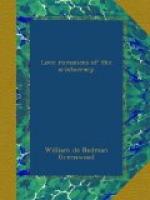The house of Fitzgerald is credited with an ancestor, one Dominus Otho, “who is supposed to have been of the family of the Gherardini of Florence. This noble passed over into Normandy, and thence, in 1057, into England, where he became so great a favourite with Edward the Confessor that he excited the jealousy of the Saxon Thanes.” Dominus Otho must too pass, with many another treasured ancestor, into the crowded genealogical land of the rejected; for the real founder of the Fitzgerald house was Walter, son of “Other,” whose name is first met with in Domesday Book in 1086. The Otho story is shown to be “absolute fiction.”
In view of such examples of misplaced ingenuity exhibited by the makers of pedigrees for our noble families, one can almost read without a smile that
“there were Heneages at Hainton in the time of King Edwy; they doubtless took part in the revolt which brought Edgar to the throne, and it is not impossible that some of them were in the train of Wulfhere, King of Mercia;”
or that
“Lord Alington comes of a family of ancient lineage, one of his ancestors being Sir Hildebrand de Alington, who was marshal to William the Conqueror at the battle of Hastings,”
though we may know full well that the Sturt pedigree really begins in the seventeenth century, and that the earliest known Heneage lived and died some three centuries before.
But “noble” families have no monopoly of misguided genealogy. “The immense majority of the pedigrees of the landed gentry,” says a well-known officer of arms, “cannot, I fear, be characterised as otherwise than utterly worthless. The errors of the ‘peerage’ are as nothing to the fables which we encounter everywhere;” and the same may be said of many another collection of pedigrees which is a treasured possession in countless British homes.
Some even justly famous men have not been proof against this insidious form of vanity and pretence. Edmund Spenser was ungenerous enough to “dismiss his known ancestry of small Lancashire gentry and plant himself modestly in the shadow of the newly discovered shield of arms of the noble house of Spencer, ‘of which I meanest boast myself to be.’” And Lord Tennyson, whose ultimate ascertainable forefather was an eighteenth century Lincolnshire apothecary, was provided with a slightly differenced cadet’s version of the arms of Archbishop Tenison, with whom he had no connection whatever.
INDEX
Aberdeen, Earl of, 299 Affleck, Lady, 66 ——, Misses, 66 Alava, General, 44 Albemarle, Lord, 235 Aldenham, Lord, 333 Alexander, Emperor, 49 Alington, Lord, 343 ——, Sir Hildebrand, 343 Allerton, Lord, 334 Almack’s, 45-49 Andrews, Mr, 71-73 Anglesey, Earl of, 165 Anne, of Austria, 2 ——, Princess, 113 ——, Queen, 331 Ardilaun, Lord, 333 Argyll, Duke of, 295 Arlington, Lady, 184 ——, Lord, 6, 182, 183 Armstrong,




